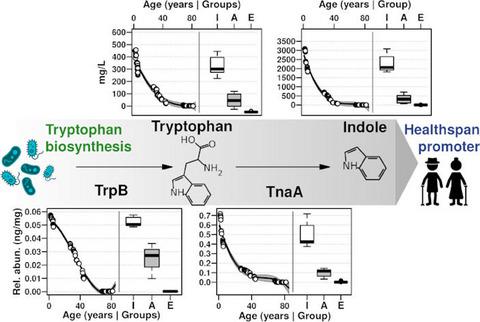当前位置:
X-MOL 学术
›
Aging Cell
›
论文详情
Our official English website, www.x-mol.net, welcomes your
feedback! (Note: you will need to create a separate account there.)
Functional microbiome deficits associated with ageing: Chronological age threshold.
Aging Cell ( IF 8.0 ) Pub Date : 2019-11-15 , DOI: 10.1111/acel.13063 Susana Ruiz-Ruiz 1, 2 , Sergio Sanchez-Carrillo 3 , Sergio Ciordia 4 , María C Mena 4 , Celia Méndez-García 3 , David Rojo 5 , Rafael Bargiela 3 , Elisa Zubeldia-Varela 5, 6 , Mónica Martínez-Martínez 3 , Coral Barbas 5 , Manuel Ferrer 3 , Andrés Moya 1, 2
Aging Cell ( IF 8.0 ) Pub Date : 2019-11-15 , DOI: 10.1111/acel.13063 Susana Ruiz-Ruiz 1, 2 , Sergio Sanchez-Carrillo 3 , Sergio Ciordia 4 , María C Mena 4 , Celia Méndez-García 3 , David Rojo 5 , Rafael Bargiela 3 , Elisa Zubeldia-Varela 5, 6 , Mónica Martínez-Martínez 3 , Coral Barbas 5 , Manuel Ferrer 3 , Andrés Moya 1, 2
Affiliation

|
Composition of the gut microbiota changes during ageing, but questions remain about whether age is also associated with deficits in microbiome function and whether these changes occur sharply or progressively. The ability to define these deficits in populations of different ages may help determine a chronological age threshold at which deficits occur and subsequently identify innovative dietary strategies for active and healthy ageing. Here, active gut microbiota and associated metabolic functions were evaluated using shotgun proteomics in three well‐defined age groups consisting of 30 healthy volunteers, namely, ten infants, ten adults and ten elderly individuals. Samples from each volunteer at intervals of up to 6 months (n = 83 samples) were used for validation. Ageing gradually increases the diversity of gut bacteria that actively synthesize proteins, that is by 1.4‐fold from infants to elderly individuals. An analysis of functional deficits consistently identifies a relationship between tryptophan and indole metabolism and ageing (p < 2.8e−8). Indeed, the synthesis of proteins involved in tryptophan and indole production and the faecal concentrations of these metabolites are directly correlated (r2 > .987) and progressively decrease with age (r2 > .948). An age threshold for a 50% decrease is observed ca. 11–31 years old, and a greater than 90% reduction is observed from the ages of 34–54 years. Based on recent investigations linking tryptophan with abundance of indole and other “healthy” longevity molecules and on the results from this small cohort study, dietary interventions aimed at manipulating tryptophan deficits since a relatively “young” age of 34 and, particularly, in the elderly are recommended.
中文翻译:

与衰老相关的功能性微生物组缺陷:按年龄分类的年龄阈值。
肠道微生物群的组成在衰老过程中会发生变化,但是仍然存在关于年龄是否也与微生物组功能缺陷有关以及这些变化是急剧发生还是逐步发生的问题。在不同年龄的人群中定义这些赤字的能力可能有助于确定发生赤字的时间顺序阈值,并随后确定用于积极健康衰老的创新饮食策略。在这里,使用shot弹枪蛋白质组学在三个明确定义的年龄组中评估了肠道活性菌群和相关的代谢功能,这些年龄组由30名健康志愿者组成,即10名婴儿,10名成人和10名老年人。每位志愿者的采样间隔为6个月(n = 83个样本)用于验证。衰老逐渐增加了积极合成蛋白质的肠道细菌的多样性,从婴儿到老年人,这种细菌的数量增加了1.4倍。对功能缺陷的分析一致地确定了色氨酸和吲哚代谢与衰老之间的关系(p <2.8e -8)。确实,涉及色氨酸和吲哚生产的蛋白质的合成以及这些代谢产物的粪便浓度直接相关(r 2 > .987),并随着年龄的增长而逐渐降低(r 2 > .948)。大约降低了50%的年龄阈值。年龄在11-31岁之间,从34-54岁的年龄开始下降了90%以上。根据近期将色氨酸与大量吲哚和其他“健康”长寿分子联系起来的调查,以及这项小型队列研究的结果,饮食干预旨在控制相对“年轻”的34岁(尤其是老年人)以来的色氨酸缺乏症。推荐。
更新日期:2019-11-15
中文翻译:

与衰老相关的功能性微生物组缺陷:按年龄分类的年龄阈值。
肠道微生物群的组成在衰老过程中会发生变化,但是仍然存在关于年龄是否也与微生物组功能缺陷有关以及这些变化是急剧发生还是逐步发生的问题。在不同年龄的人群中定义这些赤字的能力可能有助于确定发生赤字的时间顺序阈值,并随后确定用于积极健康衰老的创新饮食策略。在这里,使用shot弹枪蛋白质组学在三个明确定义的年龄组中评估了肠道活性菌群和相关的代谢功能,这些年龄组由30名健康志愿者组成,即10名婴儿,10名成人和10名老年人。每位志愿者的采样间隔为6个月(n = 83个样本)用于验证。衰老逐渐增加了积极合成蛋白质的肠道细菌的多样性,从婴儿到老年人,这种细菌的数量增加了1.4倍。对功能缺陷的分析一致地确定了色氨酸和吲哚代谢与衰老之间的关系(p <2.8e -8)。确实,涉及色氨酸和吲哚生产的蛋白质的合成以及这些代谢产物的粪便浓度直接相关(r 2 > .987),并随着年龄的增长而逐渐降低(r 2 > .948)。大约降低了50%的年龄阈值。年龄在11-31岁之间,从34-54岁的年龄开始下降了90%以上。根据近期将色氨酸与大量吲哚和其他“健康”长寿分子联系起来的调查,以及这项小型队列研究的结果,饮食干预旨在控制相对“年轻”的34岁(尤其是老年人)以来的色氨酸缺乏症。推荐。











































 京公网安备 11010802027423号
京公网安备 11010802027423号